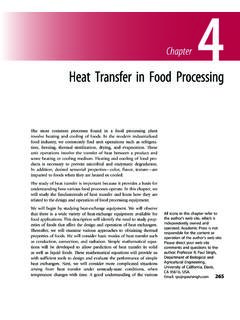Transcription of The van Hiele Levels of Geometric Understanding
1 The van Hiele Levels ofGeometric UnderstandingbyMarguerite MasonAssistant Professor of Mathematics EducationUniversity of Virginia,Charlottesville,VirginiaA husband-and-wife team of Dutch educators,Pierre van Hiele and Dina vanHiele-Geldof,noticed the difficulties that their students had in observations led them to develop a theory involving Levels ofthinking in geometry that students pass through as they progress from merelyrecognizing a figure to being able to write a formal Geometric explains why many students encounter difficulties in their geometrycourse,especially with formal proofs. The van Hieles believed that writingproofs requires thinking at a comparatively high level,and that many studentsneed to have more experiences in thinking at lower Levels before learning formalgeometric Asked are the van Hiele Levels of geometry Understanding ?
2 A .There are five Levels ,which are sequential and hierarchical. They are:Level 1 (Visualization):Students recognize figures by appearance alone,often by comparing them to a known properties of a figureare not this level,students make decisions based on perception,not 2 (Analysis):Students see figures as collections of properties. Theycan recognize and name properties of Geometric figures,but they do not seerelationships between these properties. When describing an object,a studentoperating at this level might list all the properties the student knows,but notdiscern which properties are necessary and which are sufficient to describethe object. Level 3 (Abstraction):Students perceive relationships between propertiesand between figures. At this level,students can create meaningful definitionsand give informal arguments to justify their reasoning.
3 Logical implicationsand class inclusions,such as squares being a type of rectangle, role and significance of formal deduction,however,is 4 (Deduction):Students can construct proofs,understand the role ofaxioms and definitions,and know the meaning of necessary and sufficientconditions. At this level,students should be able to construct proofs such asthose typically found in a high school geometry Handbook for Teachers, GEOMETRY: EXPLORATIONS AND APPLICATIONS4 Copyright McDougal Littell Inc. All rights 5 (Rigor):Students at this level understand the formal aspects ofdeduction,such as establishing and comparing mathematical at this level can understand the use of indirect proof and proof bycontrapositive,and can understand non-Euclidean and Battista (1992) also proposed the existence of Level 0,whichthey call pre-recognition.
4 Students at this level notice only a subset of thevisual characteristics of a shape,resulting in an inability to distinguishbetween figures. For example,they may distinguish between triangles andquadrilaterals,but may not be able to distinguish between a rhombus and ve seen other numbering schemes for the Levels . Why?A .In their original works,the van Hieles numbered the Levels from 0 to started numbering the Levels from 1 to 5 schemeallows for the pre-recognition level to be called Level 0. Pierre van Hiele srecent works describe three Levels of thought rather than articleuses the 1 to 5 numbering the development of Geometric Understanding related to age ormaturation? experience? instruction?A .Progress from one level to the next level is more dependent on educationalexperiences than on age or maturation.
5 Some experiences can facilitate (orimpede) progress within a level or to a higher level. are the phases of learning?A .According to the van Hieles,a student progresses through each level ofthought as a result of instruction that is organized into five phases phases are described :Through discussion,the teacher identifies what studentsalready know about a topic and the students become oriented to the orientation:Students explore the objects of instruction in carefullystructured tasks such as folding,measuring,or teacherensures that students explore specific :Students describe what they have learned about the topic intheir own words. The teacher introduces relevant mathematical Orientation:Students apply the relationships they are learning to solveproblems and investigate more open-ended :Students summarize and integrate what they have learned,developing a new network of objects and student may need to cycle through some of the five phases more than once with a particular Handbook for Teachers, GEOMETRY: EXPLORATIONS AND APPLICATIONSC opyright McDougal Littell Inc.
6 All rights a student skip Levels ?A .According to the van Hieles model,a student cannot achieve one level ofunderstanding without having mastered all the previous Levels . Research inthe United States and other countries supports this view with one mathematically talented students appear to skip Levels ,perhapsbecause they develop logical reasoning skills in ways other than if the teacher is thinking at a different van Hiele level than thestudents?A .This situation is common. Most high school geometry teachers think at thefourth or fifth van Hiele level. Research indicates that most students startinga high school geometry course think at the first or second level. The teacherneeds to remember that although the teacher and the student may both usethe same word,they may interpret it quite differently.
7 For example,if astudent is at the first level,the word square brings to mind a shape thatlooks like a square,but little the second level,the student thinks interms of the properties of a square,but may not know which ones arenecessary or sufficient to determine a student may feel that inorder to prove that a figure is a square,all the properties must be teacher,who is thinking at a higher level,knows not only the propertiesof a square,but also which ones can be used to prove that a figure is asquare. In fact,the teacher may think of several different ways to show that afigure is a square,since the teacher knows the relationships between thevarious properties and can determine which properties are implied by teacher must evaluate how the student is interpreting a topic in order tocommunicate happens if a teacher tries to teach at a level of thought that isabove a student s level?
8 A .Generally,the student will not understand the content that is being ,the student will try to memorize the material and may appear tohave mastered it,but the student will not actually understand the may easily forget material that has been memorized,or be unableto apply it,especially in an unfamiliar situation. a student be at the same level of Geometric Understanding in allcontent strands?A .Not necessarily. If a student has done more work with triangles than withquadrilaterals,he or she may think about triangles in a more sophisticatedway than he or she would about an unfamiliar figure such as a a student has achieved a certain level of thought in one content strand,however,it is easier for him or her to think at that level in other areas,because he or she is accustomed to seeking out relationships between figuresand between Handbook for Teachers, GEOMETRY: EXPLORATIONS AND APPLICATIONS6 Copyright McDougal Littell Inc.
9 All rights is the role of language in learning geometry?A .Language plays an important role in indicated above,each levelof thought has its own language and its own interpretation of the same and verbalizing concepts are important aspects of theInformation,Explicitation,and Integration phases of learning. Studentsclarify and reorganize their ideas through talking about can I assess a student s van Hiele level?A .There are tests that can be used to assign a van Hiele level. Within aclassroom,however,it is more practical for a teacher to assess a student svan Hiele level by analyzing his or her responses to specific Geometric example,a teacher can observe how a student uses Geometric languageand determine the student s level of thinking about triangles by analyzing hisor her responses to the triangle sorting task in Section of Geometry:Explorations and are the implications of the van Hiele theory for my instructionalpractices?
10 A .The van Hiele theory indicates that effective learning takes place whenstudents actively experience the objects of study in appropriate contexts,andwhen they engage in discussion and reflection. According to the theory,using lecture and memorization as the main methods of instruction will notlead to effective should provide their students withappropriate experiences and the opportunities to discuss them. Teachers can assess their students Levels of thought and provide instructionat those Levels . The teacher should provide experiences organized accordingto the phases of learning to develop each successive level of Geometry:Explorations and Applications,activities at the intermediatelevels are given to help students develop their Understanding of figures andproperties. Throughout the book,fundamental experiences and opportunitiesfor discussion and reflection help develop successive Levels proof is introduced,the students have had theimportant experiences necessary for is the relationship of the NCTM Curriculum and EvaluationStandards for School Mathematicsto the van Hiele theory?












